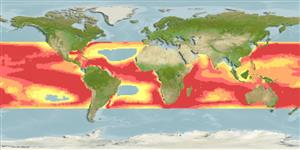Classification / Names
Common names from other countries
Main reference
Size / Weight / Age
Max length : 110 cm TL male/unsexed; (Ref. 43278); 122.0 cm TL (female); common length : 100.0 cm TL male/unsexed; (Ref. 13569)
Length at first maturity
Lm 91.6, range 89 - ? cm
Environment
Marine; pelagic-oceanic; oceanodromous (Ref. 51243); depth range 0 - 590 m (Ref. 6871), usually 0 - 200 m (Ref. 54740)
Climate / Range
Subtropical, preferred ?; 40°N - 40°S, 180°W - 180°E
Distribution
Short description
Dorsal
spines
(total): 0;
Dorsal
soft rays
(total): 0;
Anal
spines: 0;
Anal
soft rays: 0. A medium-sized spindle-shaped shark with very large eyes lacking a nictitating membrane, long gill slits extending onto dorsal surface of head, lanceolate teeth, weak keel and precaudal pits on caudal peduncle (Ref. 6871, 43278). Small and low dorsal fins, with second dorsal fin less than half the size of the first but larger than the anal fin (Ref. 6871). Pectoral fin broad and rounded (Ref. 6871). Light or dark grey above, paler below, fins white-edged, sometimes with small white spots on body and a white blotch between mouth and gill slits (Ref. 13569).
IUCN Red List Status (Ref. 115185)
Threat to humans
Harmless
Human uses
Fisheries: minor commercial
More information
ReferencesAquacultureAquaculture profileStrainsGeneticsAllele frequenciesHeritabilityDiseasesProcessingMass conversion
Tools
Special reports
Download XML
Internet sources
Estimates of some properties based on models
Phylogenetic diversity index
PD50 = 1.5000 many relatives (e.g. carps) 0.5 - 2.0 few relatives (e.g. lungfishes)
Trophic Level
4.2 ±0.60 se; Based on food items.
Resilience
Very Low, minimum population doubling time more than 14 years (Fec=4)
Vulnerability
High vulnerability (57 of 100)
Price category
